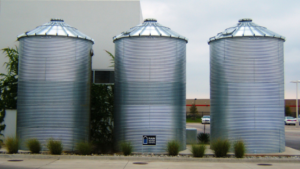Efforts across the country are underway to bolster aging water infrastructure in order to reduce stormwater impacts, shrink carbon footprints, and mitigate the heat island effect. In keeping with this focus on the environment and our commitment to the 2030 challenge of fostering sustainability, Optima McDowell Mountain Village® breaks ground in spring/summer 2023 with the distinction of being the largest private rainwater harvesting site in the United States to-date. On the cusp of this exciting and important initiative, we’re sharing insights into how rainwater harvesting heals the Earth and some of the many benefits.
There’s no denying it. Aging water infrastructure is expensive to update — especially when you look at our nation’s drinking water report card — groundwater and reservoirs are most often at the bottom of the class. However, by conserving and supplying a portion of water from the rain, you drastically reduce your draw on stressed systems.
In a natural landscape, approximately 50% of storm water infiltrates the ground, hydrating soils and recharging groundwater. Around 40% evaporates and 10% runs off.
By contrast, in developed landscapes (i.e our cities and neighborhoods), only 15% filters into the soil and a whopping 55% runs off! This is because water can’t penetrate roads, rooftops, parking lots, etc. And to make matters worse, the runoff rainwater travels along impervious surfaces toward storm drains, carrying the pollutants that were left behind. Things such as: sediment, litter (like cigarette butts), fertilizers, pet waste, yard debris, oils, and many other contaminants.
Have you ever heard the mantra: “Slow it, Spread it, Sink it, Store it”? Well, when you collect rainwater, you reduce stormwater impacts by holding water on-site rather than letting it run off.
As water gets released, it sinks back into the ground, hydrating soils, nourishing plants, and recharging the groundwater beneath us. In other words, the broken infiltration link in the hydrologic cycle is repaired.

There is a strong nexus between energy and water in our modern world. Hydroelectricity is the most obvious link, using the water stored in dams to provide renewable energy. In the state of California, for example, heating, treating, and transporting water accounts for nearly 20% of per-capita energy use! By reducing reliance on pumped water sources, we contribute to a collective savings in energy at the same time. Not to mention that rainwater harvesting will help individuals save on their water bills and cut costs for entire communities. The cost to supply overall water services can be substantially reduced when many people in one community use rainwater.

By tapping into an otherwise-wasted water source, we can create abundance in our own backyards and communities. If others do the same, we collectively have the power to bring vitality back to an ailing environment.
As we break ground on Optima McDowell Mountain Village® we will share fascinating details about how rainwater harvesting is front and center in the community’s design and construction.

